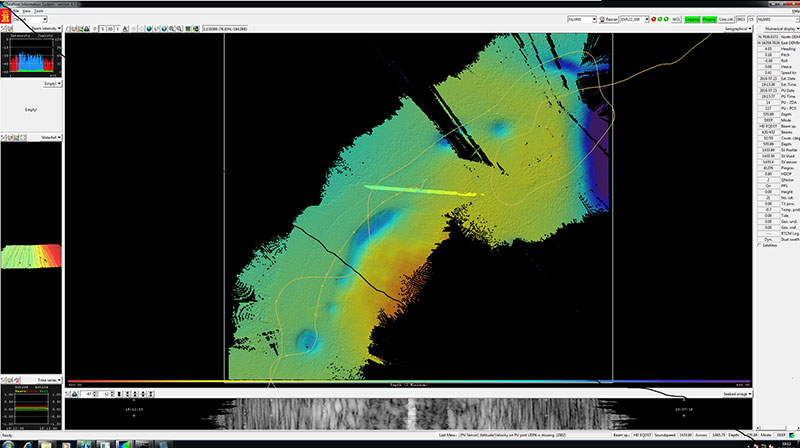
By Croy Carlin, STARC Technician, Oregon State University
July 22, 2016

This screenshot of the U.S. Coast Guard Cutter Healy’s multibeam software shows the main challenge of mapping in the Arctic. While the ship is at a science station, the mapping is clear, but the map is broken up when the ship is breaking ice. Image courtesy of Croy Carlin, STARC, The Hidden Ocean 2016: Chukchi Borderlands. Download larger version (553 KB).
Of the numerous underway scientific sensors that the U.S. Coast Guard Cutter Healy is outfitted with, the most asked about and visually appealing is certainly the technology we use to map and visualize the seafloor.
We have two systems that provide real-time data on seafloor topography. The first is our Knudsen echosounder, which acoustically pings the ocean bottom to produce a two-dimensional (profile view) of what is directly beneath the ship as we pass over it. The second system is our EM122 multibeam system. While similar to the echosounder in that it produces a visualization of the seafloor by using acoustics, this system pings the seafloor in a wide swath to either side of the ship, allowing us to make a three-dimensional plot of what the bottom looks like. In deep enough water, we can be gathering information from more than four kilometers (2.5 miles) on either side of the ship!

Croy Carlin sits in front of the many monitors and systems he manages, including the multibeam. Image courtesy of Caitlin Bailey, GFOE, The Hidden Ocean 2016: Chukchi Borderlands. Download larger version (3.8 MB).
One specific challenge of these systems in the Arctic, particularly in ice, is that getting good acoustic maps is very difficult when actively breaking ice. As a result, we have very clear images of our science stations when we’re stopped, but during transit periods, the interference from breaking ice (bubbles/ice chunks moving under the hull and over the transducers, etc.) makes for very rough imaging of the bottom.
In a screenshot from our multibeam software (photo at the top of the page), you can see our drift pattern at this particular station has resulted in an excellent image of the bottom topography, whereas the track line leading up to the station is very jagged and inconsistent. This as a result of breaking ice on our way to station.
This sort of data is used for many different applications. An example of its immediate use is, on this trip, one of the science groups was looking for long stretches of bottom that were similar both in topography (flat) and depth, as they were looking to do a benthic trawl survey. In other cases, just knowing the precise depth may be enough, for example, in the case of a coring device (on this particular trip, we’ve been doing numerous box cores).
So while surveying the bottom in this environment can be challenging, the results are highly valuable to many aspects of the scientific community.

This is an example of a great multibeam pass over one of our pockmark stations. Pockmarks are craters on the ocean floor created by fluids erupting through the sediment. Image courtesy of Croy Carlin, STARC, The Hidden Ocean 2016: Chukchi Borderlands. Download larger version (808 KB).